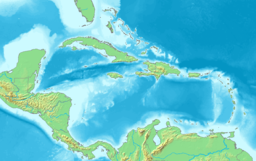Anegada Passage
| Anegada Passage | |
|---|---|
 Map of the British Virgin Islands, with the Anegada Passage labeled at right side. | |
| Location | British Virgin Islands Anguilla |
| Coordinates | 18°22′41″N 63°50′15″W / 18.37806°N 63.83750°W |
| Max. length | 200 kilometres (120 mi) |
| Max. width | 65 kilometres (40 mi) |
| Average depth | 2,300 metres (7,500 ft) |
The Anegada Passage /ˌænəˈɡɑːdə/, also known as the Anegada Trough, is a strait in the Caribbean that separates the British Virgin Islands and the British ruled Sombrero Island of Anguilla, and connects the Caribbean and the Atlantic Ocean. It is 2300 m deep. Because the threshold depths are 1800 and 1600 m, Atlantic deep water from 1600 m level may flow into the deep areas in the Caribbean Sea.[1]
The Anegada Passage is a key shipping lane for the Panama Canal.[2] Often called the "Oh-my-god-a Passage",[3] it is considered a difficult passage for sailors because of the winds, waves, and swells.[4]
The Anegada Passage was the site of the 1867 Virgin Islands earthquake and subsequent tsunami.[5][6]
Geographic extent
The multiple fault lines, ridges, and basins, including the Virgin Islands Basin, Anegada Gap, and Sombrero Basin, that form part of the general trough stretching from the southeastern Puerto Rican mainland in the Caribbean Sea to the northeastern British Virgin Island of Anegada in the North Atlantic Ocean are often collectively grouped under the name of Anegada Passage or Trough.[7][8][9][10]
See also
References
- ^ "Anegada Passage". Encyclopedia Britannica. Retrieved 1 August 2018.
- ^ "The World Factbook". CIA. Retrieved 1 August 2017.
- ^ "The "Oh-my-god-a Passage"". Motivator. Retrieved 1 August 2017.
- ^ "Anegada Passage". SV Party of Five. Archived from the original on 1 August 2018. Retrieved 1 August 2018.
- ^ "Significant Earthquake". NOAA. Retrieved 1 August 2018.
- ^ Barkan, R.; Ten Brink, U. (2010). "Tsunami Simulations of the 1867 Virgin Island Earthquake: Constraints on Epicenter Location and Fault Parameters". Bulletin of the Seismological Society of America. 100 (3): 995. Bibcode:2010BuSSA.100..995B. CiteSeerX 10.1.1.544.6624. doi:10.1785/0120090211.
- ^ "The polyphased tectonic evolution of the Anegada Passage in the northern Lesser Antilles subduction zone". ResearchGate. Retrieved 24 September 2024.
- ^ "Morphotectonics of the central Muertos thrust belt and Muertos Trough". ResearchGate. Retrieved 24 September 2024.
- ^ US Department of Commerce, National Oceanic and Atmospheric Administration. "Exploring Puerto Rico's Seamounts, Trenches, and Troughs: Background: Geology: NOAA Office of Ocean Exploration and Research". oceanexplorer.noaa.gov. Retrieved 25 September 2024.
- ^ "Core Data From Offshore Puerto Rico and the U.S. Virgin Islands | U.S. Geological Survey". www.usgs.gov. Retrieved 25 September 2024.

